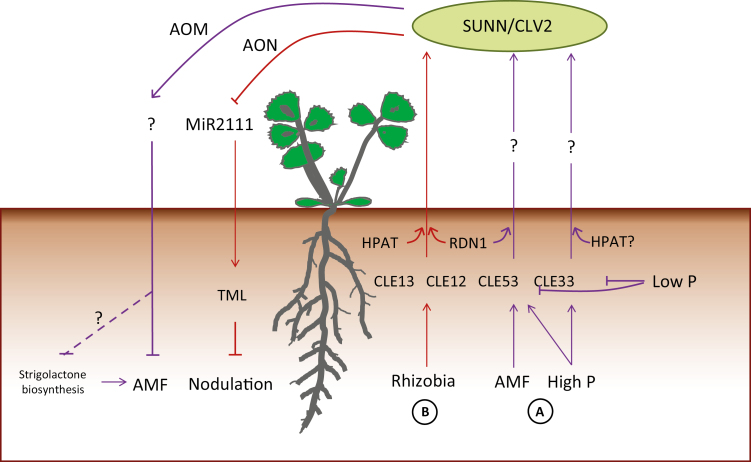Fig. 6.
Proposed model for autoregulation of mycorrhization (AOM) (A) compared with autoregulation of nodulation (B). (A) Arbuscular mycorrhizal fungi (AMF) and high phosphorus (P) induce expression of MtCLE53 and MtCLE33 compared with low P expression levels. MtCLE53 and MtCLE33 are only expressed in roots. The mature MtCLE53 and MtCLE33 peptides could be root–shoot ascending signals initiating the systemic AOM mechanisms. AOM is dependent on the leucine-rich repeat receptor-like kinase SUPER NUMERIC NODULES (SUNN) and CLAVATA2 (CLV2). MtCLE53 is further dependent on the hydroxyproline O-arabinosyl transferase (HPAT) enzyme ROOT-DETERMINED NODULATION 1 (RDN1), while the requirement for post-translational modification of MtCLE33 is unknown. Signaling events downstream of SUNN possibly reduce strigolactone biosynthesis. (B) Rhizobia induce MtCLE12 and MtCLE13 in infection sites and developing nodules. Both peptides require tri-arabinose modification, MtCLE12 by RDN1 and MtCLE13 by an unknown HPAT. The mature MtCLE12 and MtCLE13 peptides ascend to the shoot to activate SUNN. SUNN signaling represses the shoot-to-root mobile miRNA miR2111, which in turn releases expression of the Kelch-repeat F-box protein TOO MUCH LOVE (TML). TML inhibits further nodulation.

